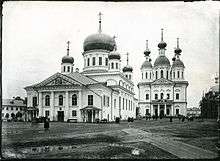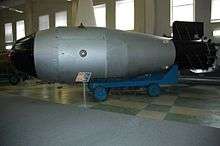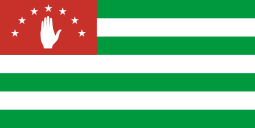Sarov
| Sarov (English) Саров (Russian) | |
|---|---|
| - Town - | |
|
| |
.svg.png) Location of Nizhny Novgorod Oblast in Russia | |
.svg.png) Sarov | |
|
| |
.png) | |
|
| |
| Administrative status (as of November 2011) | |
| Country | Russia |
| Federal subject | Nizhny Novgorod Oblast[1] |
| Administratively subordinated to | town of oblast significance of Sarov[1] |
| Administrative center of | town of oblast significance of Sarov[1] |
| Municipal status (as of December 2006) | |
| Urban okrug | Sarov Urban Okrug[2] |
| Administrative center of | Sarov Urban Okrug[2] |
| Statistics | |
| Population (2010 Census) | 92,047 inhabitants[3] |
| - Rank in 2010 | 185th |
| Time zone | MSK (UTC+03:00)[4] |
| Town status since | 1954 |
| Previous names |
Arzamas-16 (until 1991),[5] Kremlyov (until 1995)[6] |
| Postal code(s)[7] | 607188 |
| Dialing code(s) | +7 83130[8] |
|
| |
| Sarov on Wikimedia Commons | |
Sarov (Russian: Саро́в) is a closed town in Nizhny Novgorod Oblast, Russia. It was known as Arzamas-16 (Арзама́с-16)[5] from 1946 to 1991. Until 1995, it was known as Kremlyov (Кремлёв).[6] The town is closed as it is the Russian center for nuclear research. Population: 92,047 (2010 Census);[3] 87,652 (2002 Census).[9]
History

The history of the town can be divided into two different periods. In the earlier history of Russia it was known as one of the holy places of the Russian Orthodox Church, because of its monastery, that gave Russia one of its greatest saints, St. Seraphim. Since the 1940s, it has gradually become the center for research and production of Soviet and later Russian nuclear weapons.
The history of human settlement in the area around Sarov goes back at least to the 12th–13th centuries, when a large Mordvin settlement was founded on its spot. In 1298, the town was taken over by Tatars.
The modern town took its name from being the site of the Sarov Monastery next to the Sarov River. In 1664, an Orthodox monk Theodosius first settled on the Sarov hill. The first Church of Sarov tenement was founded in 1706. Saint Seraphim was living in Sarov from 1778 to 1833. In 1903, the monastery was visited by Tsar Nicholas II and other members of the royal family. At that time the monastery had nine churches, including one underground. Around 320 monks lived in the monastery.
In 1923 the monastery was closed, the monks faced Bolshevik repressions, and many were executed. During World War II, the monastery buildings were used as factories for producing rockets for BM-13 "Katyusha" rocket launchers.
In 1946, the All-Union Scientific Research Institute of Experimental Physics—a nuclear weapons design facility that would become known in the West under the acronym VNIIEF—was built.[10] Sarov became a closed city. It was removed from all unclassified maps. Initial provisional names included Base 112, Site 550, Yasnogorsk, Kremlyev and Arzamas-75.[11] Sarov was known as Arzamas-16 until 1995. In 1954, Arzamas-16 was granted town status.

The town is home to the Russian Federation Nuclear Center and "Atomic Bomb" museum which has a number of casings of Soviet-era nuclear weapons and photographs of those involved in their production. The main access is by train, which, after a security stop and inspection, is allowed into the town to disembark passengers. The small Sarov Airport is generally for government aircraft only, and visitors usually fly to Nizhny Novgorod airport and then drive.
The town is surrounded by fences patrolled by the military. Foreigners, and even Russians who do not live in Sarov, are not allowed to enter the town without permission. Foreigners who visit on business must surrender their passports, phones, and cameras to security while they are in the facility, though some documentary filmmakers have shot footage inside the town walls.
A large portion of the town is located on the grounds of the P.G.S. State Park in adjacent Temnikovsky District of the Republic of Mordovia.
In 1993, the town became a sister city to Los Alamos, New Mexico, the home of the U.S. nuclear weapons design laboratory (Los Alamos National Laboratory, or LANL). Scientists from LANL and VNIIEF have cooperated on various arms control and nuclear safeguards programs, under which the Los Alamos scientists learned, to their amusement, that their Russian colleagues paid homage to their American rivals by irreverently calling their own laboratory "Los Arzamas."
Boris Yeltsin changed the town's name back to Sarov at the request of the residents in August 1995.
On June 17, 1997, a Russian Federal Nuclear Center senior researcher Alexandr Zakharov received a fatal dose of 4850 rem in a criticality accident.[12][13]
During the 2010 Russian wildfires the Russian Army took preventive forest fire measures and radioactive material was reported to have been secured elsewhere.[14]
Today the Russian federal nuclear center is responsible for important decisions concerning the development, production, storage, and utilization of nuclear weapons; the recycling of radioactive and other materials; and research in fundamental and applied physics. International foundations have helped to fund some research scientists in Sarov following the downsizing and transitions after the Soviet era. The city's fences and the electrifed fences around fissile stores are maintained. In 1998 a resident stated that the perimeter fences also kept the city free from organized crime.[15]
Administrative and municipal status
Within the framework of administrative divisions, it is incorporated as the town of oblast significance of Sarov—an administrative unit with the status equal to that of the districts.[1] As a municipal division, the town of oblast significance of Sarov is incorporated as Sarov Urban Okrug.[2]
Notable people
- Oleg Taktarov - mixed martial artist
International relations
Twin towns and sister cities
Sarov is twinned with:
 Los Alamos, New Mexico, United States
Los Alamos, New Mexico, United States New Athos, Abkhazia (de jure Georgia)
New Athos, Abkhazia (de jure Georgia)
See also
References
Notes
- 1 2 3 4 Law #184-Z
- 1 2 3 Law #155-Z
- 1 2 Russian Federal State Statistics Service (2011). "Всероссийская перепись населения 2010 года. Том 1" [2010 All-Russian Population Census, vol. 1]. Всероссийская перепись населения 2010 года (2010 All-Russia Population Census) (in Russian). Federal State Statistics Service. Retrieved June 29, 2012.
- ↑ Правительство Российской Федерации. Федеральный закон №107-ФЗ от 3 июня 2011 г. «Об исчислении времени», в ред. Федерального закона №271-ФЗ от 03 июля 2016 г. «О внесении изменений в Федеральный закон "Об исчислении времени"». Вступил в силу по истечении шестидесяти дней после дня официального опубликования (6 августа 2011 г.). Опубликован: "Российская газета", №120, 6 июня 2011 г. (Government of the Russian Federation. Federal Law #107-FZ of June 31, 2011 On Calculating Time, as amended by the Federal Law #271-FZ of July 03, 2016 On Amending Federal Law "On Calculating Time". Effective as of after sixty days following the day of the official publication.).
- 1 2 SarovLabs. Creation of Nuclear Center Arzamas-16
- 1 2 Государственная Дума Российской Федерации. Федеральный Закон №145-ФЗ от 14 августа 1995 г. «О переименовании города Кремлёв Нижегородской области в город Саров». (State Duma of the Russian Federation. Federal Law #145-FZ of August 14, 1995 On Changing the Name of the Town of Kremlyov of Nizhny Novgorod Oblast to the Town of Sarov. ).
- ↑ Почта России. Информационно-вычислительный центр ОАСУ РПО. (Russian Post). Поиск объектов почтовой связи (Postal Objects Search) (Russian)
- ↑ My-Phone.ru. Sarov (Russian)
- ↑ Russian Federal State Statistics Service (May 21, 2004). "Численность населения России, субъектов Российской Федерации в составе федеральных округов, районов, городских поселений, сельских населённых пунктов – районных центров и сельских населённых пунктов с населением 3 тысячи и более человек" [Population of Russia, Its Federal Districts, Federal Subjects, Districts, Urban Localities, Rural Localities—Administrative Centers, and Rural Localities with Population of Over 3,000] (XLS). Всероссийская перепись населения 2002 года [All-Russia Population Census of 2002] (in Russian). Retrieved August 9, 2014.
- ↑ "Russian Military Outposts: Sarov, Russia's Los Alamos". Retrieved 9 July 2013.
- ↑ Sarovlabs. "Creation of nuclear center Arzamas-16".
- ↑ Johnston, Wm. Robert. "Arzamas-16 criticality accident, 19". Retrieved July 8, 2013.
- ↑ Kudrik, Igor (June 23, 1997). "Arzamas-16 researcher died on June 20". Retrieved July 8, 2013.
- ↑ Jenkins, Lin (August 8, 2010). "Russian troops dig canal around Sarov nuclear base as wildfires grow". The Observer. Retrieved July 9, 013. Check date values in:
|access-date=(help) - ↑ Stone, Richard (8 January 1999). "RUSSIA: Nuclear Strongholds in Peril". Science. Science. AAAS. 283 (5399): 158–164. doi:10.1126/science.283.5399.158. Retrieved July 9, 2013.
Sources
- Законодательное собрание Нижегородской области. Закон №184-З от 16 ноября 2005 г. «Об административно-территориальном устройстве Нижегородской области», в ред. Закона №67-З от 13 мая 2015 г «Об изменении административно-территориального деления Чкаловского района Нижегородской области и о внесении изменения в статью 11 Закона Нижегородской области "Об административно-территориальном устройстве Нижегородской области"». Вступил в силу по истечении десяти дней со дня официального опубликования. Опубликован: "Нижегородские новости", №218(3390), 23 ноября 2005 г. (Legislative Assembly of Nizhny Novgorod Oblast. Law #184-Z of November 16, 2005 On the Administrative-Territorial Structure of Nizhny Novgorod Oblast, as amended by the Law #67-Z of May 13, 2015 On Changing the Administrative-Territorial Structure of Chkalovsky District of Nizhny Novgorod Oblast and on Amending Article 11 of the Law of Nizhny Novgorod Oblast "On the Administrative-Territorial Structure of Nizhny Novgorod Oblast". Effective as of after ten days from the day of the official publication.).
- Законодательное Собрание Нижегородской области. Закон №155-З от 26 декабря 2006 г. «О утверждении границ и состава территории городского округа город Саров Нижегородской области». Вступил в силу по истечении десяти дней со дня официального опубликования. Опубликован: "Нижегородские новости", №2(3654), 10 января 2007 г. (Legislative Assembly of Nizhny Novgorod Oblast. Law #155-Z of December 26, 2006 On Establishing the Borders and the Territorial Composition of the Urban Okrug of the Town of Sarov of Nizhny Novgorod Oblast. Effective as of after ten days from the day of the official publication.).
- "Los Alamos and Arzamas-16: The 'Sister Cities' Relationship". Los Alamos Science. 24: 44–47. 1996.
- Yarovitcin, Roman (2012). The City That Does Not Exist. ISBN 978-1-4716-1437-8.
- Борис Забываев. "Любимый город". Саров в Internet.
- James Risen's State of War
External links
- Official website of Sarov (Russian)
- Official website of Sarov Town Duma (Russian)
- Sarov Information from the Nuclear Cities Initiative Website
- More on Sakharov (and some photographs of Sarov), from the Center for History of Physics
- The Soviet Nuclear Weapons Program (and more photographs of Sarov, including from the "Atomic Bomb" museum)
- Annotated bibliography for Arzamas-16, Russia from the Alsos Digital Library for Nuclear Issues
- English page on Sarov Monastery web-site
